Leadership Styles and Their Impact
VerifiedAdded on 2021/04/16
|9
|2509
|71
AI Summary
The given assignment is about analyzing transformational leadership styles and their impact on organizations. It includes a reference list with various articles and books that discuss transformational leadership, its differences from transactional leadership, and its effects on employee perception of team effectiveness. The assignment also mentions the real-world example of Steve Jobs, who is considered a transformational leader due to his ability to inspire enthusiasm among employees and design innovation. The solution will provide an in-depth analysis of transformational leadership styles, including their characteristics, effects on employees, and real-world examples.
Contribute Materials
Your contribution can guide someone’s learning journey. Share your
documents today.
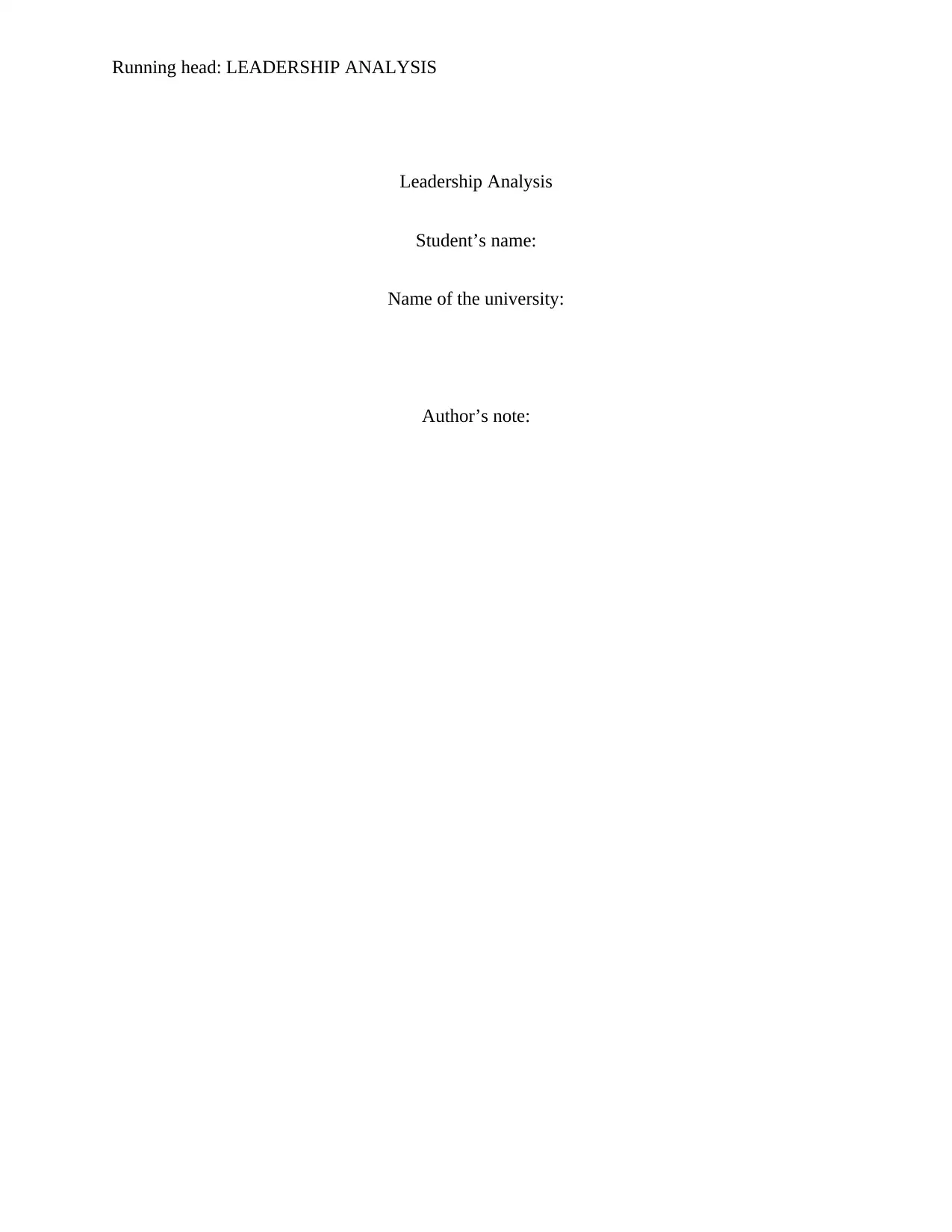
Running head: LEADERSHIP ANALYSIS
Leadership Analysis
Student’s name:
Name of the university:
Author’s note:
Leadership Analysis
Student’s name:
Name of the university:
Author’s note:
Secure Best Marks with AI Grader
Need help grading? Try our AI Grader for instant feedback on your assignments.
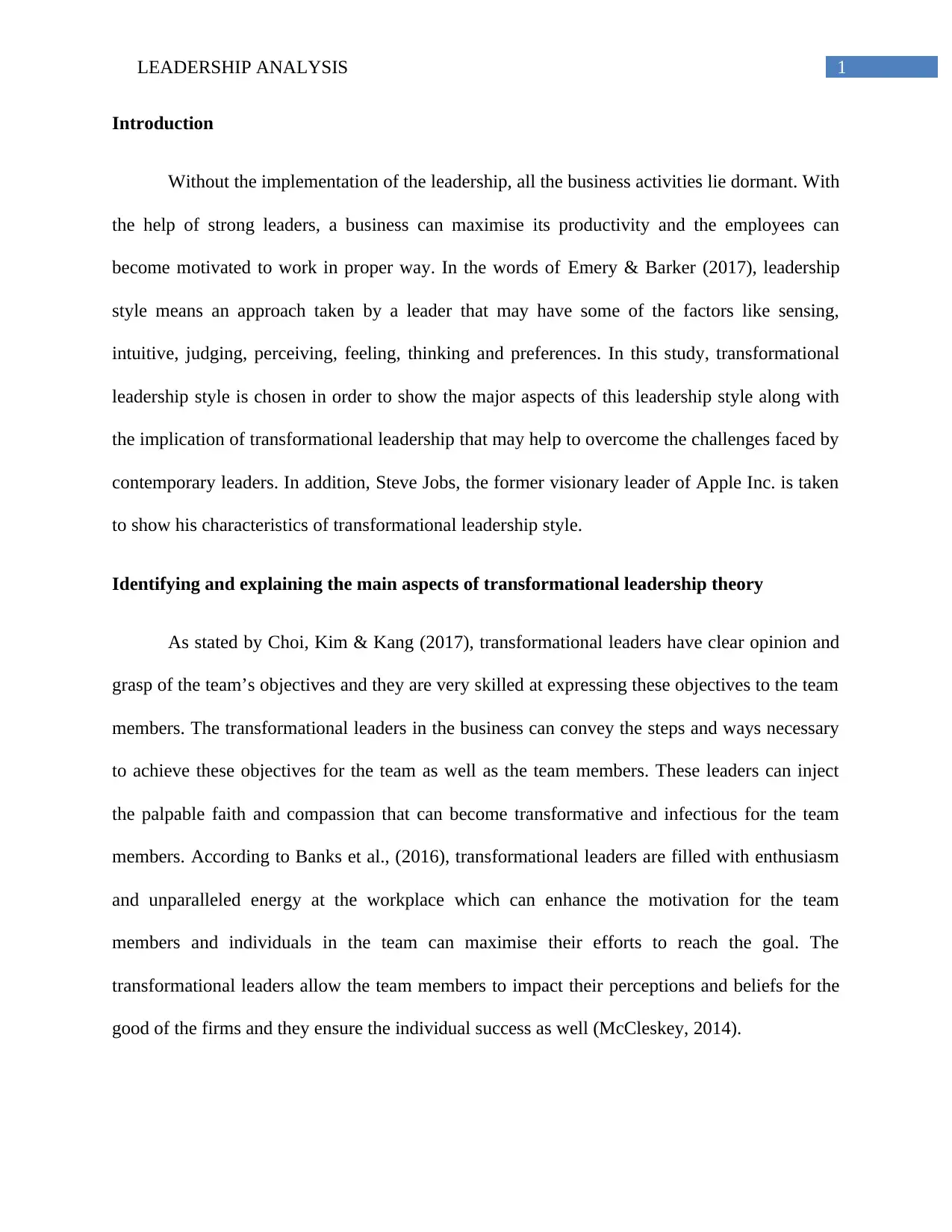
1LEADERSHIP ANALYSIS
Introduction
Without the implementation of the leadership, all the business activities lie dormant. With
the help of strong leaders, a business can maximise its productivity and the employees can
become motivated to work in proper way. In the words of Emery & Barker (2017), leadership
style means an approach taken by a leader that may have some of the factors like sensing,
intuitive, judging, perceiving, feeling, thinking and preferences. In this study, transformational
leadership style is chosen in order to show the major aspects of this leadership style along with
the implication of transformational leadership that may help to overcome the challenges faced by
contemporary leaders. In addition, Steve Jobs, the former visionary leader of Apple Inc. is taken
to show his characteristics of transformational leadership style.
Identifying and explaining the main aspects of transformational leadership theory
As stated by Choi, Kim & Kang (2017), transformational leaders have clear opinion and
grasp of the team’s objectives and they are very skilled at expressing these objectives to the team
members. The transformational leaders in the business can convey the steps and ways necessary
to achieve these objectives for the team as well as the team members. These leaders can inject
the palpable faith and compassion that can become transformative and infectious for the team
members. According to Banks et al., (2016), transformational leaders are filled with enthusiasm
and unparalleled energy at the workplace which can enhance the motivation for the team
members and individuals in the team can maximise their efforts to reach the goal. The
transformational leaders allow the team members to impact their perceptions and beliefs for the
good of the firms and they ensure the individual success as well (McCleskey, 2014).
Introduction
Without the implementation of the leadership, all the business activities lie dormant. With
the help of strong leaders, a business can maximise its productivity and the employees can
become motivated to work in proper way. In the words of Emery & Barker (2017), leadership
style means an approach taken by a leader that may have some of the factors like sensing,
intuitive, judging, perceiving, feeling, thinking and preferences. In this study, transformational
leadership style is chosen in order to show the major aspects of this leadership style along with
the implication of transformational leadership that may help to overcome the challenges faced by
contemporary leaders. In addition, Steve Jobs, the former visionary leader of Apple Inc. is taken
to show his characteristics of transformational leadership style.
Identifying and explaining the main aspects of transformational leadership theory
As stated by Choi, Kim & Kang (2017), transformational leaders have clear opinion and
grasp of the team’s objectives and they are very skilled at expressing these objectives to the team
members. The transformational leaders in the business can convey the steps and ways necessary
to achieve these objectives for the team as well as the team members. These leaders can inject
the palpable faith and compassion that can become transformative and infectious for the team
members. According to Banks et al., (2016), transformational leaders are filled with enthusiasm
and unparalleled energy at the workplace which can enhance the motivation for the team
members and individuals in the team can maximise their efforts to reach the goal. The
transformational leaders allow the team members to impact their perceptions and beliefs for the
good of the firms and they ensure the individual success as well (McCleskey, 2014).
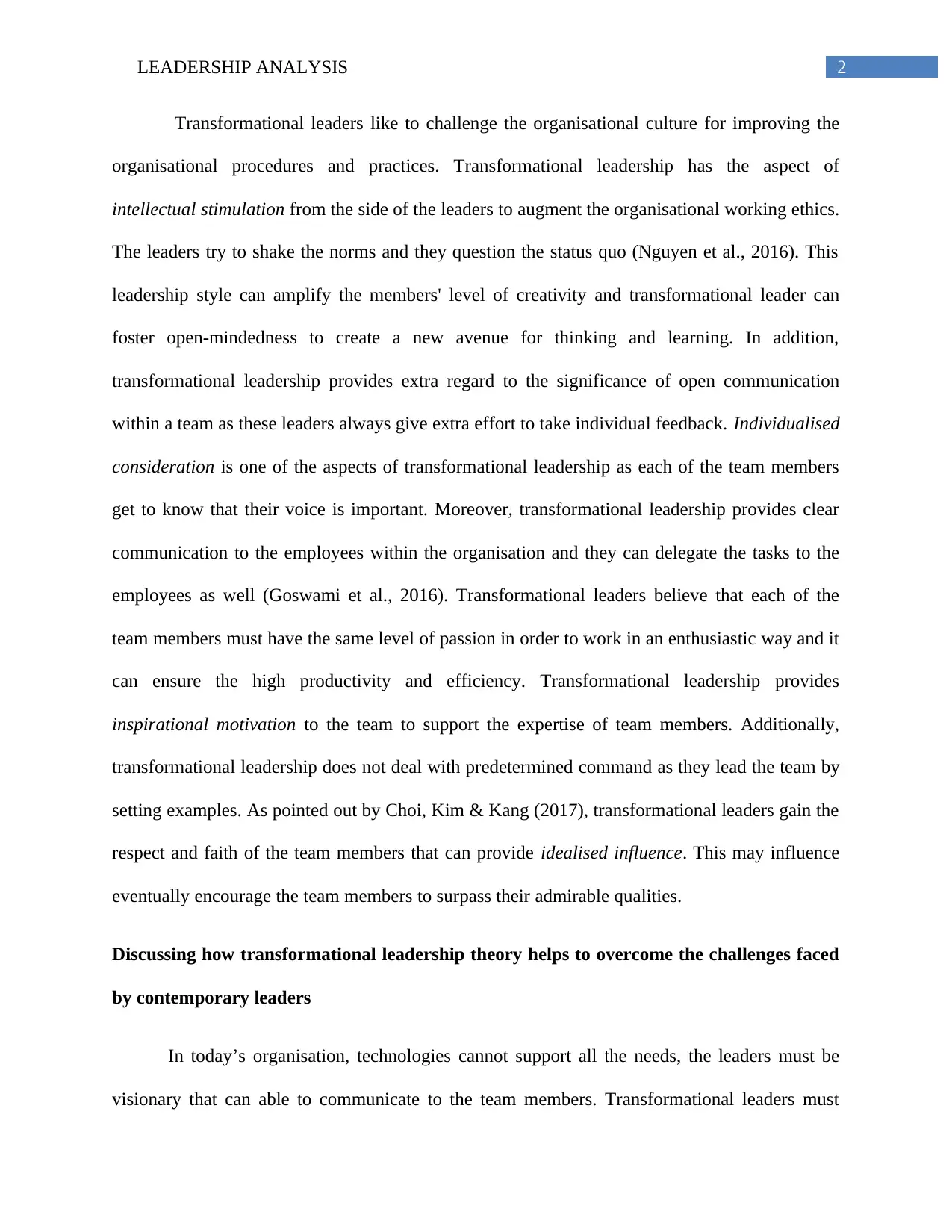
2LEADERSHIP ANALYSIS
Transformational leaders like to challenge the organisational culture for improving the
organisational procedures and practices. Transformational leadership has the aspect of
intellectual stimulation from the side of the leaders to augment the organisational working ethics.
The leaders try to shake the norms and they question the status quo (Nguyen et al., 2016). This
leadership style can amplify the members' level of creativity and transformational leader can
foster open-mindedness to create a new avenue for thinking and learning. In addition,
transformational leadership provides extra regard to the significance of open communication
within a team as these leaders always give extra effort to take individual feedback. Individualised
consideration is one of the aspects of transformational leadership as each of the team members
get to know that their voice is important. Moreover, transformational leadership provides clear
communication to the employees within the organisation and they can delegate the tasks to the
employees as well (Goswami et al., 2016). Transformational leaders believe that each of the
team members must have the same level of passion in order to work in an enthusiastic way and it
can ensure the high productivity and efficiency. Transformational leadership provides
inspirational motivation to the team to support the expertise of team members. Additionally,
transformational leadership does not deal with predetermined command as they lead the team by
setting examples. As pointed out by Choi, Kim & Kang (2017), transformational leaders gain the
respect and faith of the team members that can provide idealised influence. This may influence
eventually encourage the team members to surpass their admirable qualities.
Discussing how transformational leadership theory helps to overcome the challenges faced
by contemporary leaders
In today’s organisation, technologies cannot support all the needs, the leaders must be
visionary that can able to communicate to the team members. Transformational leaders must
Transformational leaders like to challenge the organisational culture for improving the
organisational procedures and practices. Transformational leadership has the aspect of
intellectual stimulation from the side of the leaders to augment the organisational working ethics.
The leaders try to shake the norms and they question the status quo (Nguyen et al., 2016). This
leadership style can amplify the members' level of creativity and transformational leader can
foster open-mindedness to create a new avenue for thinking and learning. In addition,
transformational leadership provides extra regard to the significance of open communication
within a team as these leaders always give extra effort to take individual feedback. Individualised
consideration is one of the aspects of transformational leadership as each of the team members
get to know that their voice is important. Moreover, transformational leadership provides clear
communication to the employees within the organisation and they can delegate the tasks to the
employees as well (Goswami et al., 2016). Transformational leaders believe that each of the
team members must have the same level of passion in order to work in an enthusiastic way and it
can ensure the high productivity and efficiency. Transformational leadership provides
inspirational motivation to the team to support the expertise of team members. Additionally,
transformational leadership does not deal with predetermined command as they lead the team by
setting examples. As pointed out by Choi, Kim & Kang (2017), transformational leaders gain the
respect and faith of the team members that can provide idealised influence. This may influence
eventually encourage the team members to surpass their admirable qualities.
Discussing how transformational leadership theory helps to overcome the challenges faced
by contemporary leaders
In today’s organisation, technologies cannot support all the needs, the leaders must be
visionary that can able to communicate to the team members. Transformational leaders must
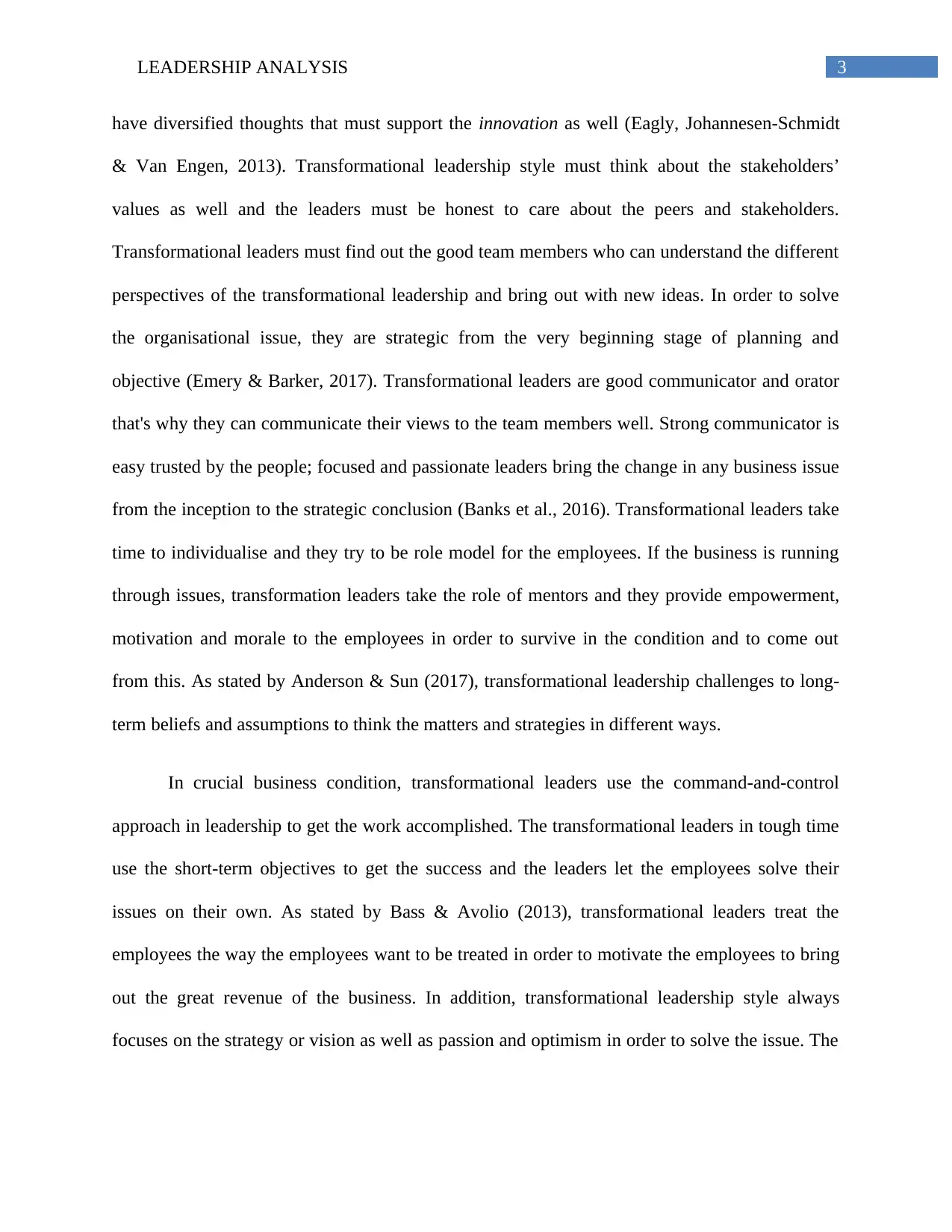
3LEADERSHIP ANALYSIS
have diversified thoughts that must support the innovation as well (Eagly, Johannesen-Schmidt
& Van Engen, 2013). Transformational leadership style must think about the stakeholders’
values as well and the leaders must be honest to care about the peers and stakeholders.
Transformational leaders must find out the good team members who can understand the different
perspectives of the transformational leadership and bring out with new ideas. In order to solve
the organisational issue, they are strategic from the very beginning stage of planning and
objective (Emery & Barker, 2017). Transformational leaders are good communicator and orator
that's why they can communicate their views to the team members well. Strong communicator is
easy trusted by the people; focused and passionate leaders bring the change in any business issue
from the inception to the strategic conclusion (Banks et al., 2016). Transformational leaders take
time to individualise and they try to be role model for the employees. If the business is running
through issues, transformation leaders take the role of mentors and they provide empowerment,
motivation and morale to the employees in order to survive in the condition and to come out
from this. As stated by Anderson & Sun (2017), transformational leadership challenges to long-
term beliefs and assumptions to think the matters and strategies in different ways.
In crucial business condition, transformational leaders use the command-and-control
approach in leadership to get the work accomplished. The transformational leaders in tough time
use the short-term objectives to get the success and the leaders let the employees solve their
issues on their own. As stated by Bass & Avolio (2013), transformational leaders treat the
employees the way the employees want to be treated in order to motivate the employees to bring
out the great revenue of the business. In addition, transformational leadership style always
focuses on the strategy or vision as well as passion and optimism in order to solve the issue. The
have diversified thoughts that must support the innovation as well (Eagly, Johannesen-Schmidt
& Van Engen, 2013). Transformational leadership style must think about the stakeholders’
values as well and the leaders must be honest to care about the peers and stakeholders.
Transformational leaders must find out the good team members who can understand the different
perspectives of the transformational leadership and bring out with new ideas. In order to solve
the organisational issue, they are strategic from the very beginning stage of planning and
objective (Emery & Barker, 2017). Transformational leaders are good communicator and orator
that's why they can communicate their views to the team members well. Strong communicator is
easy trusted by the people; focused and passionate leaders bring the change in any business issue
from the inception to the strategic conclusion (Banks et al., 2016). Transformational leaders take
time to individualise and they try to be role model for the employees. If the business is running
through issues, transformation leaders take the role of mentors and they provide empowerment,
motivation and morale to the employees in order to survive in the condition and to come out
from this. As stated by Anderson & Sun (2017), transformational leadership challenges to long-
term beliefs and assumptions to think the matters and strategies in different ways.
In crucial business condition, transformational leaders use the command-and-control
approach in leadership to get the work accomplished. The transformational leaders in tough time
use the short-term objectives to get the success and the leaders let the employees solve their
issues on their own. As stated by Bass & Avolio (2013), transformational leaders treat the
employees the way the employees want to be treated in order to motivate the employees to bring
out the great revenue of the business. In addition, transformational leadership style always
focuses on the strategy or vision as well as passion and optimism in order to solve the issue. The
Secure Best Marks with AI Grader
Need help grading? Try our AI Grader for instant feedback on your assignments.
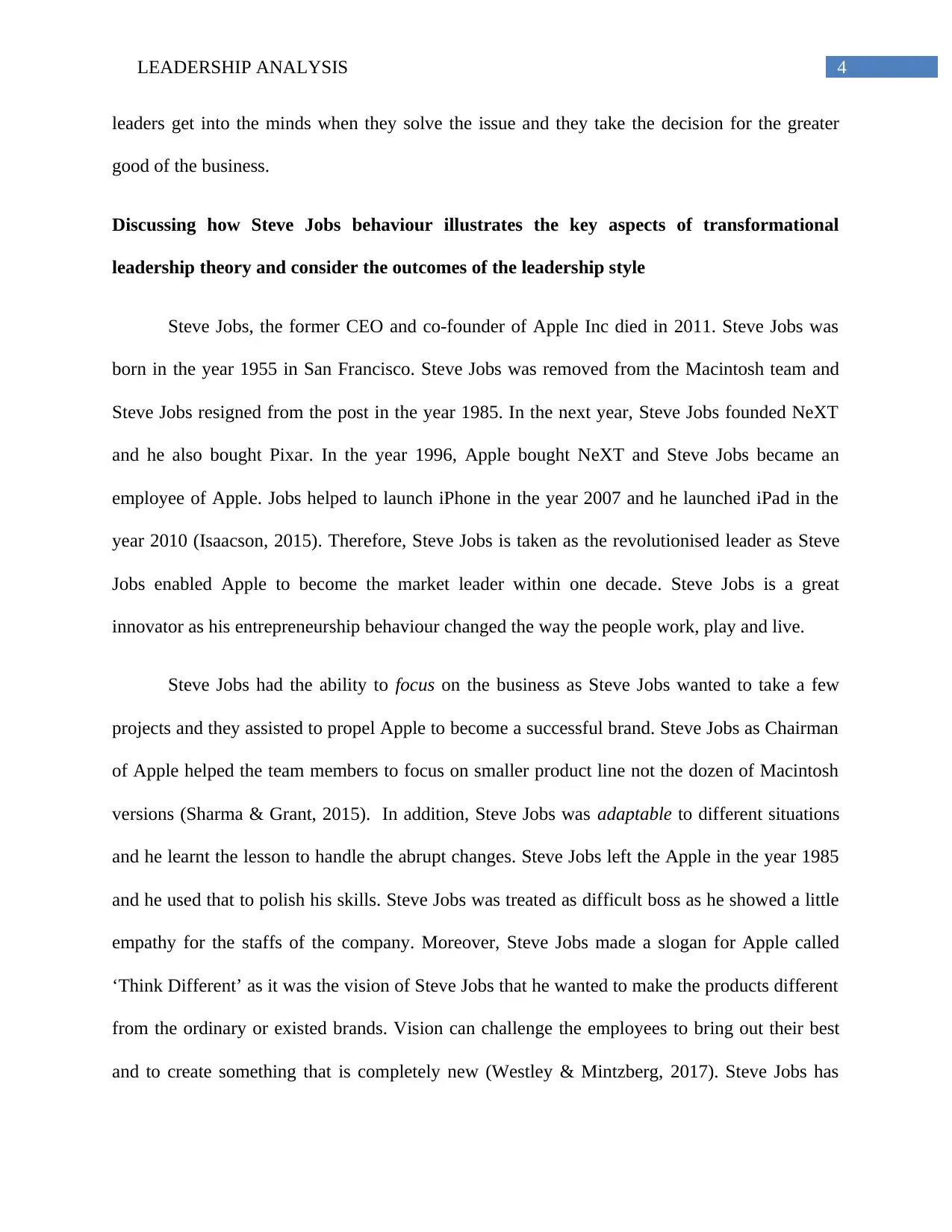
4LEADERSHIP ANALYSIS
leaders get into the minds when they solve the issue and they take the decision for the greater
good of the business.
Discussing how Steve Jobs behaviour illustrates the key aspects of transformational
leadership theory and consider the outcomes of the leadership style
Steve Jobs, the former CEO and co-founder of Apple Inc died in 2011. Steve Jobs was
born in the year 1955 in San Francisco. Steve Jobs was removed from the Macintosh team and
Steve Jobs resigned from the post in the year 1985. In the next year, Steve Jobs founded NeXT
and he also bought Pixar. In the year 1996, Apple bought NeXT and Steve Jobs became an
employee of Apple. Jobs helped to launch iPhone in the year 2007 and he launched iPad in the
year 2010 (Isaacson, 2015). Therefore, Steve Jobs is taken as the revolutionised leader as Steve
Jobs enabled Apple to become the market leader within one decade. Steve Jobs is a great
innovator as his entrepreneurship behaviour changed the way the people work, play and live.
Steve Jobs had the ability to focus on the business as Steve Jobs wanted to take a few
projects and they assisted to propel Apple to become a successful brand. Steve Jobs as Chairman
of Apple helped the team members to focus on smaller product line not the dozen of Macintosh
versions (Sharma & Grant, 2015). In addition, Steve Jobs was adaptable to different situations
and he learnt the lesson to handle the abrupt changes. Steve Jobs left the Apple in the year 1985
and he used that to polish his skills. Steve Jobs was treated as difficult boss as he showed a little
empathy for the staffs of the company. Moreover, Steve Jobs made a slogan for Apple called
‘Think Different’ as it was the vision of Steve Jobs that he wanted to make the products different
from the ordinary or existed brands. Vision can challenge the employees to bring out their best
and to create something that is completely new (Westley & Mintzberg, 2017). Steve Jobs has
leaders get into the minds when they solve the issue and they take the decision for the greater
good of the business.
Discussing how Steve Jobs behaviour illustrates the key aspects of transformational
leadership theory and consider the outcomes of the leadership style
Steve Jobs, the former CEO and co-founder of Apple Inc died in 2011. Steve Jobs was
born in the year 1955 in San Francisco. Steve Jobs was removed from the Macintosh team and
Steve Jobs resigned from the post in the year 1985. In the next year, Steve Jobs founded NeXT
and he also bought Pixar. In the year 1996, Apple bought NeXT and Steve Jobs became an
employee of Apple. Jobs helped to launch iPhone in the year 2007 and he launched iPad in the
year 2010 (Isaacson, 2015). Therefore, Steve Jobs is taken as the revolutionised leader as Steve
Jobs enabled Apple to become the market leader within one decade. Steve Jobs is a great
innovator as his entrepreneurship behaviour changed the way the people work, play and live.
Steve Jobs had the ability to focus on the business as Steve Jobs wanted to take a few
projects and they assisted to propel Apple to become a successful brand. Steve Jobs as Chairman
of Apple helped the team members to focus on smaller product line not the dozen of Macintosh
versions (Sharma & Grant, 2015). In addition, Steve Jobs was adaptable to different situations
and he learnt the lesson to handle the abrupt changes. Steve Jobs left the Apple in the year 1985
and he used that to polish his skills. Steve Jobs was treated as difficult boss as he showed a little
empathy for the staffs of the company. Moreover, Steve Jobs made a slogan for Apple called
‘Think Different’ as it was the vision of Steve Jobs that he wanted to make the products different
from the ordinary or existed brands. Vision can challenge the employees to bring out their best
and to create something that is completely new (Westley & Mintzberg, 2017). Steve Jobs has
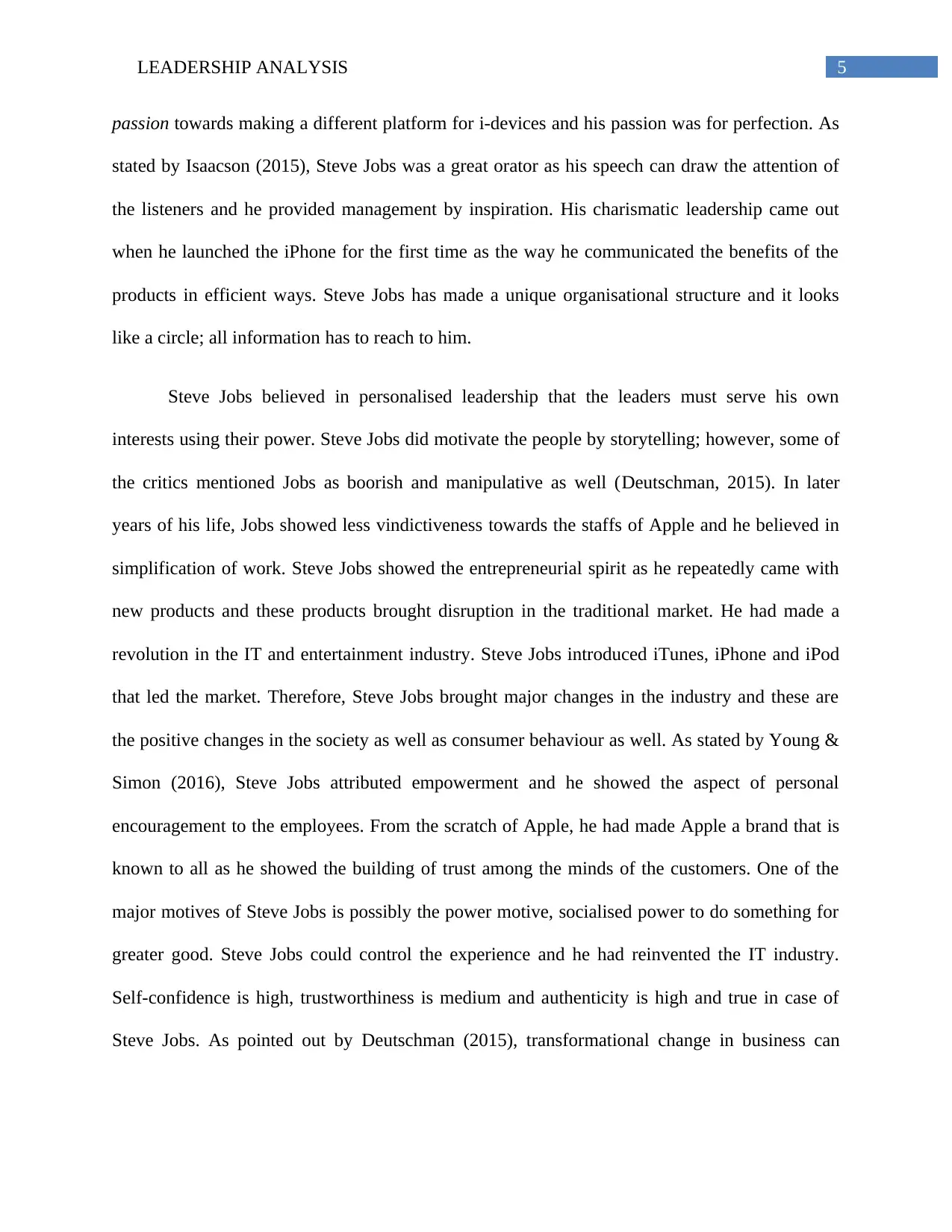
5LEADERSHIP ANALYSIS
passion towards making a different platform for i-devices and his passion was for perfection. As
stated by Isaacson (2015), Steve Jobs was a great orator as his speech can draw the attention of
the listeners and he provided management by inspiration. His charismatic leadership came out
when he launched the iPhone for the first time as the way he communicated the benefits of the
products in efficient ways. Steve Jobs has made a unique organisational structure and it looks
like a circle; all information has to reach to him.
Steve Jobs believed in personalised leadership that the leaders must serve his own
interests using their power. Steve Jobs did motivate the people by storytelling; however, some of
the critics mentioned Jobs as boorish and manipulative as well (Deutschman, 2015). In later
years of his life, Jobs showed less vindictiveness towards the staffs of Apple and he believed in
simplification of work. Steve Jobs showed the entrepreneurial spirit as he repeatedly came with
new products and these products brought disruption in the traditional market. He had made a
revolution in the IT and entertainment industry. Steve Jobs introduced iTunes, iPhone and iPod
that led the market. Therefore, Steve Jobs brought major changes in the industry and these are
the positive changes in the society as well as consumer behaviour as well. As stated by Young &
Simon (2016), Steve Jobs attributed empowerment and he showed the aspect of personal
encouragement to the employees. From the scratch of Apple, he had made Apple a brand that is
known to all as he showed the building of trust among the minds of the customers. One of the
major motives of Steve Jobs is possibly the power motive, socialised power to do something for
greater good. Steve Jobs could control the experience and he had reinvented the IT industry.
Self-confidence is high, trustworthiness is medium and authenticity is high and true in case of
Steve Jobs. As pointed out by Deutschman (2015), transformational change in business can
passion towards making a different platform for i-devices and his passion was for perfection. As
stated by Isaacson (2015), Steve Jobs was a great orator as his speech can draw the attention of
the listeners and he provided management by inspiration. His charismatic leadership came out
when he launched the iPhone for the first time as the way he communicated the benefits of the
products in efficient ways. Steve Jobs has made a unique organisational structure and it looks
like a circle; all information has to reach to him.
Steve Jobs believed in personalised leadership that the leaders must serve his own
interests using their power. Steve Jobs did motivate the people by storytelling; however, some of
the critics mentioned Jobs as boorish and manipulative as well (Deutschman, 2015). In later
years of his life, Jobs showed less vindictiveness towards the staffs of Apple and he believed in
simplification of work. Steve Jobs showed the entrepreneurial spirit as he repeatedly came with
new products and these products brought disruption in the traditional market. He had made a
revolution in the IT and entertainment industry. Steve Jobs introduced iTunes, iPhone and iPod
that led the market. Therefore, Steve Jobs brought major changes in the industry and these are
the positive changes in the society as well as consumer behaviour as well. As stated by Young &
Simon (2016), Steve Jobs attributed empowerment and he showed the aspect of personal
encouragement to the employees. From the scratch of Apple, he had made Apple a brand that is
known to all as he showed the building of trust among the minds of the customers. One of the
major motives of Steve Jobs is possibly the power motive, socialised power to do something for
greater good. Steve Jobs could control the experience and he had reinvented the IT industry.
Self-confidence is high, trustworthiness is medium and authenticity is high and true in case of
Steve Jobs. As pointed out by Deutschman (2015), transformational change in business can
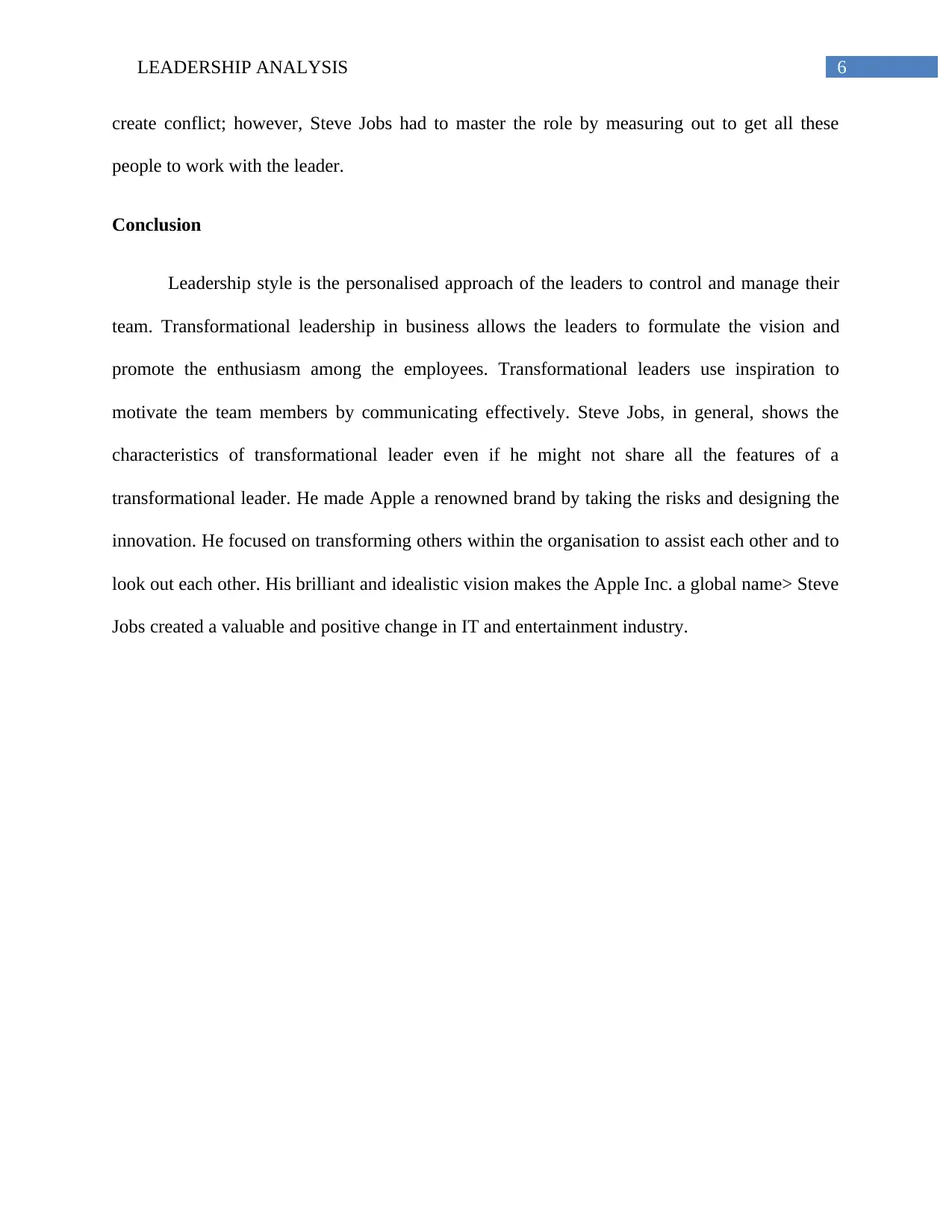
6LEADERSHIP ANALYSIS
create conflict; however, Steve Jobs had to master the role by measuring out to get all these
people to work with the leader.
Conclusion
Leadership style is the personalised approach of the leaders to control and manage their
team. Transformational leadership in business allows the leaders to formulate the vision and
promote the enthusiasm among the employees. Transformational leaders use inspiration to
motivate the team members by communicating effectively. Steve Jobs, in general, shows the
characteristics of transformational leader even if he might not share all the features of a
transformational leader. He made Apple a renowned brand by taking the risks and designing the
innovation. He focused on transforming others within the organisation to assist each other and to
look out each other. His brilliant and idealistic vision makes the Apple Inc. a global name> Steve
Jobs created a valuable and positive change in IT and entertainment industry.
create conflict; however, Steve Jobs had to master the role by measuring out to get all these
people to work with the leader.
Conclusion
Leadership style is the personalised approach of the leaders to control and manage their
team. Transformational leadership in business allows the leaders to formulate the vision and
promote the enthusiasm among the employees. Transformational leaders use inspiration to
motivate the team members by communicating effectively. Steve Jobs, in general, shows the
characteristics of transformational leader even if he might not share all the features of a
transformational leader. He made Apple a renowned brand by taking the risks and designing the
innovation. He focused on transforming others within the organisation to assist each other and to
look out each other. His brilliant and idealistic vision makes the Apple Inc. a global name> Steve
Jobs created a valuable and positive change in IT and entertainment industry.
Paraphrase This Document
Need a fresh take? Get an instant paraphrase of this document with our AI Paraphraser
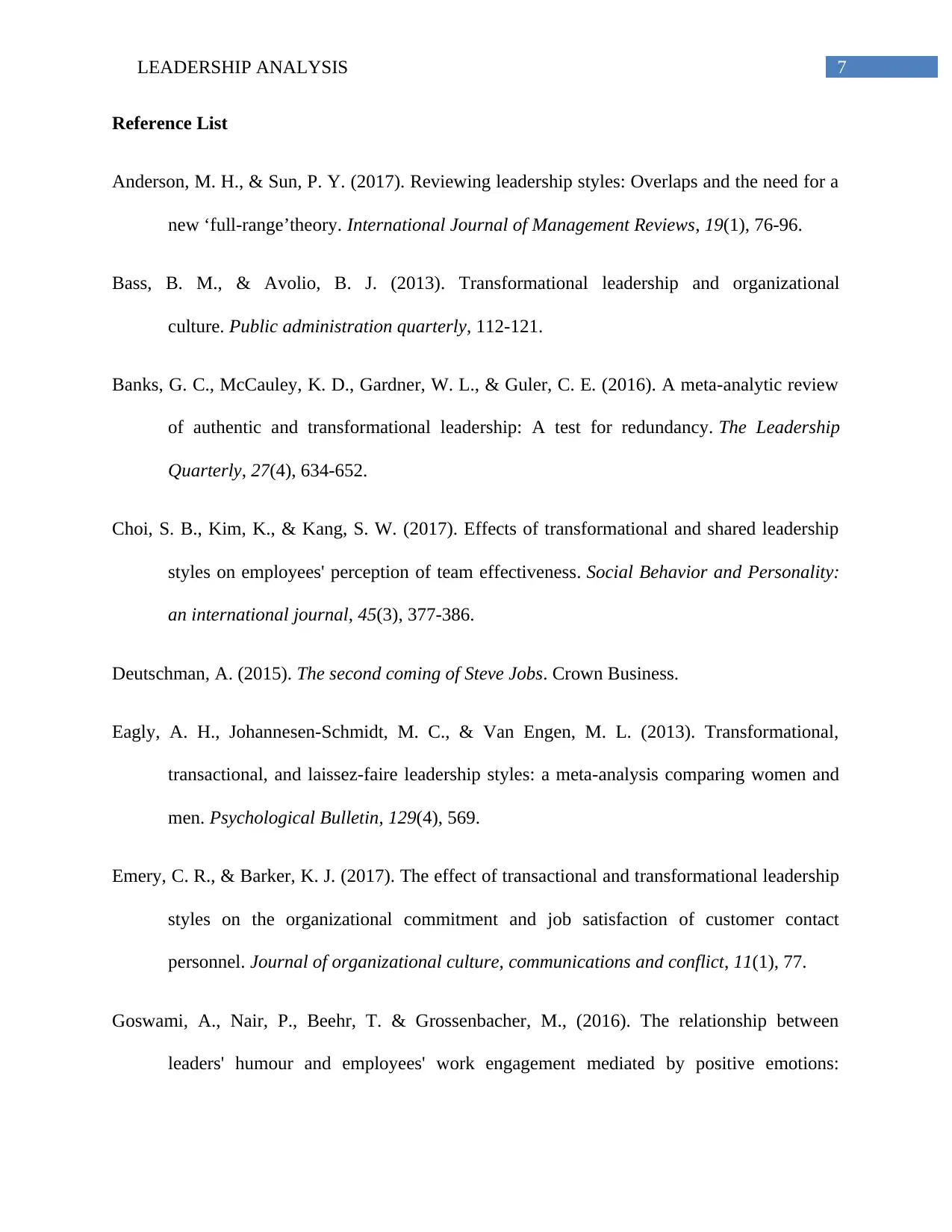
7LEADERSHIP ANALYSIS
Reference List
Anderson, M. H., & Sun, P. Y. (2017). Reviewing leadership styles: Overlaps and the need for a
new ‘full‐range’theory. International Journal of Management Reviews, 19(1), 76-96.
Bass, B. M., & Avolio, B. J. (2013). Transformational leadership and organizational
culture. Public administration quarterly, 112-121.
Banks, G. C., McCauley, K. D., Gardner, W. L., & Guler, C. E. (2016). A meta-analytic review
of authentic and transformational leadership: A test for redundancy. The Leadership
Quarterly, 27(4), 634-652.
Choi, S. B., Kim, K., & Kang, S. W. (2017). Effects of transformational and shared leadership
styles on employees' perception of team effectiveness. Social Behavior and Personality:
an international journal, 45(3), 377-386.
Deutschman, A. (2015). The second coming of Steve Jobs. Crown Business.
Eagly, A. H., Johannesen-Schmidt, M. C., & Van Engen, M. L. (2013). Transformational,
transactional, and laissez-faire leadership styles: a meta-analysis comparing women and
men. Psychological Bulletin, 129(4), 569.
Emery, C. R., & Barker, K. J. (2017). The effect of transactional and transformational leadership
styles on the organizational commitment and job satisfaction of customer contact
personnel. Journal of organizational culture, communications and conflict, 11(1), 77.
Goswami, A., Nair, P., Beehr, T. & Grossenbacher, M., (2016). The relationship between
leaders' humour and employees' work engagement mediated by positive emotions:
Reference List
Anderson, M. H., & Sun, P. Y. (2017). Reviewing leadership styles: Overlaps and the need for a
new ‘full‐range’theory. International Journal of Management Reviews, 19(1), 76-96.
Bass, B. M., & Avolio, B. J. (2013). Transformational leadership and organizational
culture. Public administration quarterly, 112-121.
Banks, G. C., McCauley, K. D., Gardner, W. L., & Guler, C. E. (2016). A meta-analytic review
of authentic and transformational leadership: A test for redundancy. The Leadership
Quarterly, 27(4), 634-652.
Choi, S. B., Kim, K., & Kang, S. W. (2017). Effects of transformational and shared leadership
styles on employees' perception of team effectiveness. Social Behavior and Personality:
an international journal, 45(3), 377-386.
Deutschman, A. (2015). The second coming of Steve Jobs. Crown Business.
Eagly, A. H., Johannesen-Schmidt, M. C., & Van Engen, M. L. (2013). Transformational,
transactional, and laissez-faire leadership styles: a meta-analysis comparing women and
men. Psychological Bulletin, 129(4), 569.
Emery, C. R., & Barker, K. J. (2017). The effect of transactional and transformational leadership
styles on the organizational commitment and job satisfaction of customer contact
personnel. Journal of organizational culture, communications and conflict, 11(1), 77.
Goswami, A., Nair, P., Beehr, T. & Grossenbacher, M., (2016). The relationship between
leaders' humour and employees' work engagement mediated by positive emotions:
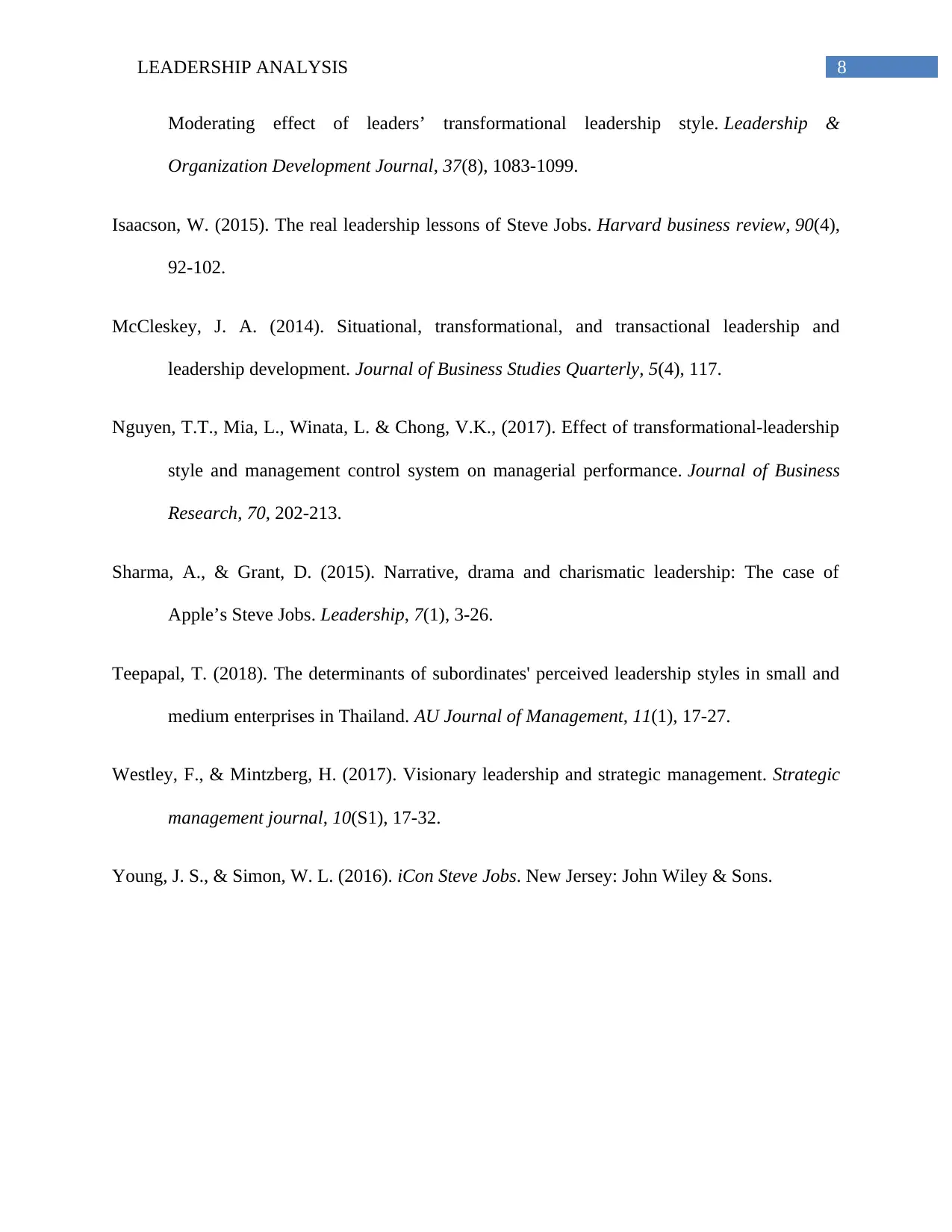
8LEADERSHIP ANALYSIS
Moderating effect of leaders’ transformational leadership style. Leadership &
Organization Development Journal, 37(8), 1083-1099.
Isaacson, W. (2015). The real leadership lessons of Steve Jobs. Harvard business review, 90(4),
92-102.
McCleskey, J. A. (2014). Situational, transformational, and transactional leadership and
leadership development. Journal of Business Studies Quarterly, 5(4), 117.
Nguyen, T.T., Mia, L., Winata, L. & Chong, V.K., (2017). Effect of transformational-leadership
style and management control system on managerial performance. Journal of Business
Research, 70, 202-213.
Sharma, A., & Grant, D. (2015). Narrative, drama and charismatic leadership: The case of
Apple’s Steve Jobs. Leadership, 7(1), 3-26.
Teepapal, T. (2018). The determinants of subordinates' perceived leadership styles in small and
medium enterprises in Thailand. AU Journal of Management, 11(1), 17-27.
Westley, F., & Mintzberg, H. (2017). Visionary leadership and strategic management. Strategic
management journal, 10(S1), 17-32.
Young, J. S., & Simon, W. L. (2016). iCon Steve Jobs. New Jersey: John Wiley & Sons.
Moderating effect of leaders’ transformational leadership style. Leadership &
Organization Development Journal, 37(8), 1083-1099.
Isaacson, W. (2015). The real leadership lessons of Steve Jobs. Harvard business review, 90(4),
92-102.
McCleskey, J. A. (2014). Situational, transformational, and transactional leadership and
leadership development. Journal of Business Studies Quarterly, 5(4), 117.
Nguyen, T.T., Mia, L., Winata, L. & Chong, V.K., (2017). Effect of transformational-leadership
style and management control system on managerial performance. Journal of Business
Research, 70, 202-213.
Sharma, A., & Grant, D. (2015). Narrative, drama and charismatic leadership: The case of
Apple’s Steve Jobs. Leadership, 7(1), 3-26.
Teepapal, T. (2018). The determinants of subordinates' perceived leadership styles in small and
medium enterprises in Thailand. AU Journal of Management, 11(1), 17-27.
Westley, F., & Mintzberg, H. (2017). Visionary leadership and strategic management. Strategic
management journal, 10(S1), 17-32.
Young, J. S., & Simon, W. L. (2016). iCon Steve Jobs. New Jersey: John Wiley & Sons.
1 out of 9
Related Documents
Your All-in-One AI-Powered Toolkit for Academic Success.
+13062052269
info@desklib.com
Available 24*7 on WhatsApp / Email
![[object Object]](/_next/static/media/star-bottom.7253800d.svg)
Unlock your academic potential
© 2024 | Zucol Services PVT LTD | All rights reserved.





